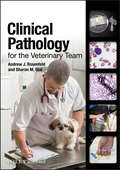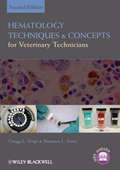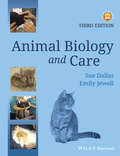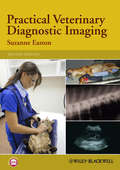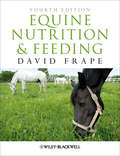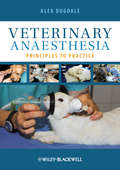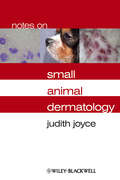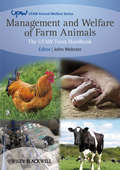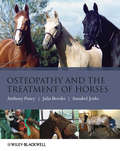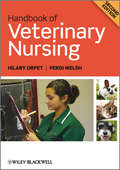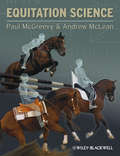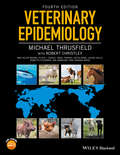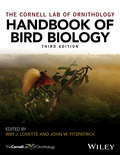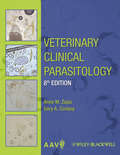- Table View
- List View
Clinical Pathology for the Veterinary Team
by Andrew J. Rosenfeld Sharon M. DialClinical Pathology for the Veterinary Team is a concise, reliable resource for technical team members performing clinical diagnostic evaluation. Focusing on sample handling, machinery calibration, normal physiology and anatomy, clinical diagnostics, and disease processes, the book helps technical team members to consistently achieve high-quality results in small animal lab work. An essential bench-side reference for in-house laboratories, the book includes a DVD with interactive cases to build skills in reading and interpreting digital slides. With chapters on blood counts, chemistry, urinalysis and electrolytes, advanced diagnostics, and cytology, Clinical Pathology for the Veterinary Team offers key technical information for consistently obtaining and evaluating samples. The book is a practical resource for anyone performing lab work, including veterinary technicians, technician and veterinary students, and veterinarians.
Clinical Pathology for the Veterinary Team
by Andrew J. Rosenfeld Sharon M. DialClinical Pathology for the Veterinary Team is a concise, reliable resource for technical team members performing clinical diagnostic evaluation. Focusing on sample handling, machinery calibration, normal physiology and anatomy, clinical diagnostics, and disease processes, the book helps technical team members to consistently achieve high-quality results in small animal lab work. An essential bench-side reference for in-house laboratories, the book includes a DVD with interactive cases to build skills in reading and interpreting digital slides. With chapters on blood counts, chemistry, urinalysis and electrolytes, advanced diagnostics, and cytology, Clinical Pathology for the Veterinary Team offers key technical information for consistently obtaining and evaluating samples. The book is a practical resource for anyone performing lab work, including veterinary technicians, technician and veterinary students, and veterinarians.
Hematology Techniques and Concepts for Veterinary Technicians
by Gregg L. Voigt Shannon L. SwistNow in full color, Hematology Techniques and Concepts for Veterinary Technicians, Second Edition is a thorough update to this introduction to the fundamental concepts of collecting, handling, and preparing hematology samples. Covering the basics of blood composition, cell morphology, and sample collection, handling, and preparation, the book is designed specifically for veterinary technicians and students to gain a full understanding of why each test is performed and ensure accurate test results. In addition to addressing advances in technology, equipment, and test techniques throughout, a new chapter covers automated testing, and a companion website provides review questions and images from the book for download at www.wiley.com/go/voigt. Key concepts have also been added to each chapter to better promote learning, and terms are now defined throughout the text, with the definitions collected into a glossary. User-friendly and well-illustrated with charts, reference values, algorithms and photomicrographs, Hematology Techniques and Concepts for Veterinary Technicians, Second Edition is a key reference for veterinary technicians and veterinary technology students.
Animal Biology and Care
by Sue Dallas Emily JewellThe perfect study companion, Animal Biology and Care, 3rd Edition is specifically designed for students on animal care, animal nursing assistant and veterinary care assistant courses. This edition is fully updated with new course content, a refreshed design and colour illustrations throughout. Basic biological theory is introduced with diagrams for visual learners while photographs demonstrate the common practical procedures carried out by animal care assistants. Key features include: New content on exotic species, recognising the increasing number of these animals kept as pets. Extensive coverage of the Animal Welfare Act 2006 and recent advances in animal welfare. Written in line with course curricula, chapter summaries help you to remember key points and learning objectives. A companion website has interactive MCQs to help you test your knowledge. Divided into three main sections covering animal science and genetics, health and husbandry and nursing procedures, this book will help lay the foundations for a successful career in animal care and management!
Animal Biology and Care
by Sue Dallas Emily JewellThe perfect study companion, Animal Biology and Care, 3rd Edition is specifically designed for students on animal care, animal nursing assistant and veterinary care assistant courses. This edition is fully updated with new course content, a refreshed design and colour illustrations throughout. Basic biological theory is introduced with diagrams for visual learners while photographs demonstrate the common practical procedures carried out by animal care assistants. Key features include: New content on exotic species, recognising the increasing number of these animals kept as pets. Extensive coverage of the Animal Welfare Act 2006 and recent advances in animal welfare. Written in line with course curricula, chapter summaries help you to remember key points and learning objectives. A companion website has interactive MCQs to help you test your knowledge. Divided into three main sections covering animal science and genetics, health and husbandry and nursing procedures, this book will help lay the foundations for a successful career in animal care and management!
Practical Veterinary Diagnostic Imaging
by Suzanne EastonPractical Veterinary Diagnostic Imaging is an essential and practical guide to the various diagnostic imaging modalities that are used in veterinary practice. It moves from basic mathematic and physical principles through to discussion of equipment and practical methods. Radiographic techniques for both small and large animals are covered. There is a separate chapter devoted to ultrasound, as well as discussion of advanced imaging techniques such as fluoroscopy, computerised tomography and magnetic resonance imaging. The book also covers legislation and safety issues in the context of their impact on the veterinary practice. Presented with clear line diagrams and photographs, Practical Veterinary Diagnostic Imaging also provides revision points and self-assessment questions in each chapter to aid study. It is an ideal guide for student and qualified veterinary nurses. It is also a useful reference for veterinary students and veterinarians in general practice who want a basic guide to radiography and other imaging modalities. KEY FEATURES Everything you need to know about diagnostic imaging in veterinary practice in a language you can easily understand The basic principles of physics presented in simple terms Improves your positioning techniques with practical tips for best practice Clear guidance on the use of digital imaging to improve image quality and reduce radiation doses to patients Companion website with additional resources (available at www.wiley.com/go/easton/diagnosticimaging)
Practical Veterinary Diagnostic Imaging
by Suzanne EastonPractical Veterinary Diagnostic Imaging is an essential and practical guide to the various diagnostic imaging modalities that are used in veterinary practice. It moves from basic mathematic and physical principles through to discussion of equipment and practical methods. Radiographic techniques for both small and large animals are covered. There is a separate chapter devoted to ultrasound, as well as discussion of advanced imaging techniques such as fluoroscopy, computerised tomography and magnetic resonance imaging. The book also covers legislation and safety issues in the context of their impact on the veterinary practice. Presented with clear line diagrams and photographs, Practical Veterinary Diagnostic Imaging also provides revision points and self-assessment questions in each chapter to aid study. It is an ideal guide for student and qualified veterinary nurses. It is also a useful reference for veterinary students and veterinarians in general practice who want a basic guide to radiography and other imaging modalities. KEY FEATURES Everything you need to know about diagnostic imaging in veterinary practice in a language you can easily understand The basic principles of physics presented in simple terms Improves your positioning techniques with practical tips for best practice Clear guidance on the use of digital imaging to improve image quality and reduce radiation doses to patients Companion website with additional resources (available at www.wiley.com/go/easton/diagnosticimaging)
Equine Nutrition and Feeding
by David FrapeSince the first edition of Equine Nutrition and Feeding was published in 1986, it has become the seminal work on the subject. It covers all the key topics that you need to know for your equine nutrition degree course. This comprehensive and clearly evidenced textbook covers how food is digested and nutrients are used in growing, working and breeding horses. It also explains the scientific basis for calculating nutrient and dietary requirements in an understandable manner, and shows you how to do these calculations. Special attention is also given to grassland and pasture, and to housing and diet-related diseases. Additional, student-friendly features include: References to the most up-to-date information, including “Nutrient Requirements of Horses”, from the National Research Council (2007). Case histories to provide practical examples. Study questions at the end of each chapter to help you to revise. A comprehensive glossary of terms and abbreviations. Changes to this fourth edition: Evidence base has been expanded, with 646 new research reports and papers being incorporated. Extensively revised to make navigation easier. A new section is dedicated to the weaning and growth of the foal. This book is the essential text for any undergraduate and postgraduate student of equine nutrition, equine veterinary medicine, equine veterinary nursing or agricultural science. It is also used by equine nutritionists and horse owners.
Equine Nutrition and Feeding
by David FrapeSince the first edition of Equine Nutrition and Feeding was published in 1986, it has become the seminal work on the subject. It covers all the key topics that you need to know for your equine nutrition degree course. This comprehensive and clearly evidenced textbook covers how food is digested and nutrients are used in growing, working and breeding horses. It also explains the scientific basis for calculating nutrient and dietary requirements in an understandable manner, and shows you how to do these calculations. Special attention is also given to grassland and pasture, and to housing and diet-related diseases. Additional, student-friendly features include: References to the most up-to-date information, including “Nutrient Requirements of Horses”, from the National Research Council (2007). Case histories to provide practical examples. Study questions at the end of each chapter to help you to revise. A comprehensive glossary of terms and abbreviations. Changes to this fourth edition: Evidence base has been expanded, with 646 new research reports and papers being incorporated. Extensively revised to make navigation easier. A new section is dedicated to the weaning and growth of the foal. This book is the essential text for any undergraduate and postgraduate student of equine nutrition, equine veterinary medicine, equine veterinary nursing or agricultural science. It is also used by equine nutritionists and horse owners.
Veterinary Anaesthesia: Principles to Practice
by Alexandra DugdaleThis comprehensive textbook covers the key principles of veterinary anaesthesia and encompasses a wide range of species. Information is summarised in a simple, reader-friendly format, while still providing the detail you need for an advanced level of study. The easy-reference structure is designed to help you identify and access topics of interest quickly. Over 180 photographs and line drawings illustrate the scientific principles, equipment and the techniques you need to know. A self-test section at the end of every chapter helps you to learn and revise each topic. As well as the technical and species-based chapters, you will find useful chapters that you can refer to as part of your daily practice: Quick Reference Guide to Analgesic Infusions Trouble-shooting for common problems encountered in anaesthetised patients Anaesthetic Machine Checks Canine, Feline and Equine Emergency Drug Dose Charts Designed specifically for veterinary students and those preparing to take advanced qualifications in veterinary anaesthesia. It is also a useful reference for veterinarians in practice and advanced veterinary nurses and technicians.
Notes on Small Animal Dermatology
by Judith JoycePart of the popular ‘Notes On’ series, this book is full of practical advice and information on diagnosing and treating common dermatological problems in small animals. The rapid reference format is designed to help you locate information as quickly as possible. Information on common dermatological complaints is offered in different ways to meet a variety of needs. Firstly a problem-orientated perspective is provided, and then a disease-based perspective looking at what underlying problems cause particular diseases. This is followed by a section that looks at dermatological disease by anatomical location, and a section that outlines different treatments. •Supplemented with full-colour photographs throughout to aid diagnosis •Detailed flow-diagrams illustrate the problem-orientated approach •Text is laid out in note form for ease of reference This book is ideal for veterinary students, new practitioners and established professionals who need a quick refresher
Veterinary Anaesthesia: Principles to Practice
by Alexandra DugdaleThis comprehensive textbook covers the key principles of veterinary anaesthesia and encompasses a wide range of species. Information is summarised in a simple, reader-friendly format, while still providing the detail you need for an advanced level of study. The easy-reference structure is designed to help you identify and access topics of interest quickly. Over 180 photographs and line drawings illustrate the scientific principles, equipment and the techniques you need to know. A self-test section at the end of every chapter helps you to learn and revise each topic. As well as the technical and species-based chapters, you will find useful chapters that you can refer to as part of your daily practice: Quick Reference Guide to Analgesic Infusions Trouble-shooting for common problems encountered in anaesthetised patients Anaesthetic Machine Checks Canine, Feline and Equine Emergency Drug Dose Charts Designed specifically for veterinary students and those preparing to take advanced qualifications in veterinary anaesthesia. It is also a useful reference for veterinarians in practice and advanced veterinary nurses and technicians.
Notes on Small Animal Dermatology (Notes On Ser.)
by Judith JoycePart of the popular ‘Notes On’ series, this book is full of practical advice and information on diagnosing and treating common dermatological problems in small animals. The rapid reference format is designed to help you locate information as quickly as possible. Information on common dermatological complaints is offered in different ways to meet a variety of needs. Firstly a problem-orientated perspective is provided, and then a disease-based perspective looking at what underlying problems cause particular diseases. This is followed by a section that looks at dermatological disease by anatomical location, and a section that outlines different treatments. •Supplemented with full-colour photographs throughout to aid diagnosis •Detailed flow-diagrams illustrate the problem-orientated approach •Text is laid out in note form for ease of reference This book is ideal for veterinary students, new practitioners and established professionals who need a quick refresher
Management and Welfare of Farm Animals: The UFAW Farm Handbook (UFAW Animal Welfare #9)
by John WebsterThrough successive editions, Management and Welfare of Farm Animals has gained international recognition as a classic introductory textbook for students of agriculture and veterinary science. Conceived by the Universities Federation for Animal Welfare (UFAW), the book has always sought to promote the humane treatment of livestock within the practical business context of modern farming. Now fully revised and updated, this fifth edition remains the most comprehensive and accessible guide available. Three animal groups appear here for the first time (game birds, South American camelids, and ostriches), and a chapter on horses has also been restored. Throughout, the book offers clear advice for the humane management of all major farmed species in the primary context of large-scale food production. However, this edition also takes full account of consumer demand (and legal requirements) for alternative farming methods and enhanced welfare standards, whether in conventional agriculture or the smallest of ‘hobby' farms. Brand new chapters reflect fresh understanding of welfare science, ethics, and the role of society in ensuring the best possible farm conditions. It remains an indispensable resource for students, and for all those seeking to promote animal welfare. Published as a part of the prestigious Wiley-Blackwell – UFAW Animal Welfare series. UFAW, founded 1926, is an internationally recognised, independent, scientific and educational animal welfare charity. For full details of all titles available in the UFAW series, please visit www.wiley.com/go/ufaw.
Management and Welfare of Farm Animals: The UFAW Farm Handbook (UFAW Animal Welfare #11)
by John WebsterThrough successive editions, Management and Welfare of Farm Animals has gained international recognition as a classic introductory textbook for students of agriculture and veterinary science. Conceived by the Universities Federation for Animal Welfare (UFAW), the book has always sought to promote the humane treatment of livestock within the practical business context of modern farming. Now fully revised and updated, this fifth edition remains the most comprehensive and accessible guide available. Three animal groups appear here for the first time (game birds, South American camelids, and ostriches), and a chapter on horses has also been restored. Throughout, the book offers clear advice for the humane management of all major farmed species in the primary context of large-scale food production. However, this edition also takes full account of consumer demand (and legal requirements) for alternative farming methods and enhanced welfare standards, whether in conventional agriculture or the smallest of ‘hobby' farms. Brand new chapters reflect fresh understanding of welfare science, ethics, and the role of society in ensuring the best possible farm conditions. It remains an indispensable resource for students, and for all those seeking to promote animal welfare. Published as a part of the prestigious Wiley-Blackwell – UFAW Animal Welfare series. UFAW, founded 1926, is an internationally recognised, independent, scientific and educational animal welfare charity. For full details of all titles available in the UFAW series, please visit www.wiley.com/go/ufaw.
Osteopathy and the Treatment of Horses
by Anthony Pusey Julia Brooks Annabel JenksWritten by pioneering and internationally-renowned specialists in the field, this text provides clinically-orientated information on osteopathy as a treatment for horses. It explains the scientific rationale of how osteopathy works in animals, as well as providing a detailed working guide to the technical skills and procedures you need to know to perform safe and effective osteopathic procedures. Drawing on well established practices for humans this book provides details on the full variety of diagnostic and therapeutic osteopathic procedures that can be used on horses. Full of practical information, it demonstrates how professionals treating equine locomotor problems can adapt different procedures in different clinical settings. Over 350 colour images and detailed step-by-step instructions demonstrate the procedures and practice of osteopathy. Covers treatment both with and without sedation and general anaesthetic. This comprehensive text is written for students and practitioners of osteopathy with an interest in treating horses. It will also be useful to other allied therapists, and to veterinary practitioners who want to know more about the treatment of musculoskeletal problems.
Handbook of Veterinary Nursing
by Hilary Orpet Perdi WelshHandbook of Veterinary Nursing presents essential guidance and helpful tips on developing and delivering high quality nursing care and skills. Fully updated, this easy-to-follow guide reflects recent changes to veterinary nursing qualifications, current terminology and drugs in use. The emphasis is on the importance of working methodically, using high quality procedures, to help the whole veterinary team ensure the most successful outcomes in animal care. Written in note form for quick reference by veterinary nurses and technicians at all stages of their training and career, this will be invaluable for both exam revision and quick reference in clinic. Contents include: The nursing process in veterinary care, physical assessment of the patient, managing the hospital environment, managing the operating room, surgical nursing activities, anaesthesia, diagnostic imaging, diagnostic tests, triage and emergency procedures, and essential calculations for drugs, fluids, nutrition and radiographic exposures. Key features: •Gives clinical advice quickly and simply •Written by authors with many years experience of veterinary nurse training and education •Contains essential calculations •Illustrated in colour throughout
Handbook of Veterinary Nursing
by Hilary Orpet Perdi WelshHandbook of Veterinary Nursing presents essential guidance and helpful tips on developing and delivering high quality nursing care and skills. Fully updated, this easy-to-follow guide reflects recent changes to veterinary nursing qualifications, current terminology and drugs in use. The emphasis is on the importance of working methodically, using high quality procedures, to help the whole veterinary team ensure the most successful outcomes in animal care. Written in note form for quick reference by veterinary nurses and technicians at all stages of their training and career, this will be invaluable for both exam revision and quick reference in clinic. Contents include: The nursing process in veterinary care, physical assessment of the patient, managing the hospital environment, managing the operating room, surgical nursing activities, anaesthesia, diagnostic imaging, diagnostic tests, triage and emergency procedures, and essential calculations for drugs, fluids, nutrition and radiographic exposures. Key features: •Gives clinical advice quickly and simply •Written by authors with many years experience of veterinary nurse training and education •Contains essential calculations •Illustrated in colour throughout
Equitation Science: Equitation Science In Practice
by Paul McGreevy Andrew McLeanWritten by two internationally recognised experts, Equitation Science is the first book to draw together the principles of this emerging field into a much-needed coherent source of information. The goal of equitation science is to enhance our understanding of how horses think and learn, and to use their natural behaviour to train, ride or compete with them in as fair a manner as possible. The welfare consequences of training and competing horses under different protocols are explored. Drawing on traditional and emergent techniques, this book incorporates learning theory into an ethical equine training system suitable for all levels. It also focuses on evidence-based approaches that improve rider safety. "Equitation Science is one of those rare books that is going to change the way we train and manage horses forever. It brings together a fundamental understanding of the way horses think and behave and presents a system of modern training that has the welfare of the horse at its core – it must be the foundation work for the next generation of professional and amateur riders and trainers. Riders will ride better, trainers will train better and we will have happier, healthier horses."—Wayne Channon, International Grand Prix Rider "I found this a very interesting and enlightening book. Equitation Science will help anyone involved with horses to understand them more and to be more effective in their training and education. The knowledge this brings to anyone involved with horses should help to make the horses’ lives easier and therefore allow the partnership between humans and equines to flourish."—Yogi Breisner, British Eventing Performance Manager "Equitation Science is an ambitious and thorough look at an enormous range of areas, approaches and factors concerning the training of horses. The authors have an underlying theme to their text of scientifically assessing and then also promoting the use of ethical and humane methods of horse training to increase all sport horses’ welfare and happiness within their sporting requirements. Equitation Science also provides an invaluable insight as to how and why what we do with our horses actually works."—Paul Tapner, Professional International Advanced Eventing Rider, Badminton CCI**** 2010 Winner
Equitation Science
by Paul McGreevy Andrew McLeanWritten by two internationally recognised experts, Equitation Science is the first book to draw together the principles of this emerging field into a much-needed coherent source of information. The goal of equitation science is to enhance our understanding of how horses think and learn, and to use their natural behaviour to train, ride or compete with them in as fair a manner as possible. The welfare consequences of training and competing horses under different protocols are explored. Drawing on traditional and emergent techniques, this book incorporates learning theory into an ethical equine training system suitable for all levels. It also focuses on evidence-based approaches that improve rider safety. "Equitation Science is one of those rare books that is going to change the way we train and manage horses forever. It brings together a fundamental understanding of the way horses think and behave and presents a system of modern training that has the welfare of the horse at its core – it must be the foundation work for the next generation of professional and amateur riders and trainers. Riders will ride better, trainers will train better and we will have happier, healthier horses."—Wayne Channon, International Grand Prix Rider "I found this a very interesting and enlightening book. Equitation Science will help anyone involved with horses to understand them more and to be more effective in their training and education. The knowledge this brings to anyone involved with horses should help to make the horses’ lives easier and therefore allow the partnership between humans and equines to flourish."—Yogi Breisner, British Eventing Performance Manager "Equitation Science is an ambitious and thorough look at an enormous range of areas, approaches and factors concerning the training of horses. The authors have an underlying theme to their text of scientifically assessing and then also promoting the use of ethical and humane methods of horse training to increase all sport horses’ welfare and happiness within their sporting requirements. Equitation Science also provides an invaluable insight as to how and why what we do with our horses actually works."—Paul Tapner, Professional International Advanced Eventing Rider, Badminton CCI**** 2010 Winner
Veterinary Epidemiology
by Michael ThrusfieldA comprehensive introduction to the role of epidemiology in veterinary medicine This fully revised and expanded edition of Veterinary Epidemiology introduces readers to the field of veterinary epidemiology. The new edition also adds new chapters on the design of observational studies, validity in epidemiological studies, systematic reviews, and statistical modelling, to deliver more advanced material. This updated edition begins by offering an historical perspective on the development of veterinary medicine. It then addresses the full scope of epidemiology, with chapters covering causality, disease occurrence, determinants, disease patterns, disease ecology, and much more. Veterinary Epidemiology, Fourth Edition: ● Features updates of all chapters to provide a current resource on the subject of veterinary epidemiology ● Presents new chapters essential to the continued advancement of the field ● Includes examples from companion animal, livestock, and avian medicine, as well as aquatic animal diseases ● Focuses on the principles and concepts of epidemiology, surveillance, and diagnostic-test validation and performance ● Includes access to a companion website providing multiple choice questions Veterinary Epidemiology is an invaluable reference for veterinary general practitioners, government veterinarians, agricultural economists, and members of other disciplines interested in animal disease. It is also essential reading for epidemiology students at both the undergraduate and postgraduate levels.
Veterinary Epidemiology
by Michael ThrusfieldA comprehensive introduction to the role of epidemiology in veterinary medicine This fully revised and expanded edition of Veterinary Epidemiology introduces readers to the field of veterinary epidemiology. The new edition also adds new chapters on the design of observational studies, validity in epidemiological studies, systematic reviews, and statistical modelling, to deliver more advanced material. This updated edition begins by offering an historical perspective on the development of veterinary medicine. It then addresses the full scope of epidemiology, with chapters covering causality, disease occurrence, determinants, disease patterns, disease ecology, and much more. Veterinary Epidemiology, Fourth Edition: ● Features updates of all chapters to provide a current resource on the subject of veterinary epidemiology ● Presents new chapters essential to the continued advancement of the field ● Includes examples from companion animal, livestock, and avian medicine, as well as aquatic animal diseases ● Focuses on the principles and concepts of epidemiology, surveillance, and diagnostic-test validation and performance ● Includes access to a companion website providing multiple choice questions Veterinary Epidemiology is an invaluable reference for veterinary general practitioners, government veterinarians, agricultural economists, and members of other disciplines interested in animal disease. It is also essential reading for epidemiology students at both the undergraduate and postgraduate levels.
Handbook of Bird Biology
by Irby J. Lovette John W. FitzpatrickSelected by Forbes.com as one of the 12 best books about birds and birding in 2016 This much-anticipated third edition of the Handbook of Bird Biology is an essential and comprehensive resource for everyone interested in learning more about birds, from casual bird watchers to formal students of ornithology. Wherever you study birds your enjoyment will be enhanced by a better understanding of the incredible diversity of avian lifestyles. Arising from the renowned Cornell Lab of Ornithology and authored by a team of experts from around the world, the Handbook covers all aspects of avian diversity, behaviour, ecology, evolution, physiology, and conservation. Using examples drawn from birds found in every corner of the globe, it explores and distills the many scientific discoveries that have made birds one of our best known - and best loved - parts of the natural world. This edition has been completely revised and is presented with more than 800 full color images. It provides readers with a tool for life-long learning about birds and is suitable for bird watchers and ornithology students, as well as for ecologists, conservationists, and resource managers who work with birds. The Handbook of Bird Biology is the companion volume to the Cornell Lab’s renowned distance learning course, Ornithology: Comprehensive Bird Biology.
Handbook of Bird Biology
by Cornell Laboratory John W. Fitzpatrick Irby J. LovetteSelected by Forbes.com as one of the 12 best books about birds and birding in 2016 This much-anticipated third edition of the Handbook of Bird Biology is an essential and comprehensive resource for everyone interested in learning more about birds, from casual bird watchers to formal students of ornithology. Wherever you study birds your enjoyment will be enhanced by a better understanding of the incredible diversity of avian lifestyles. Arising from the renowned Cornell Lab of Ornithology and authored by a team of experts from around the world, the Handbook covers all aspects of avian diversity, behaviour, ecology, evolution, physiology, and conservation. Using examples drawn from birds found in every corner of the globe, it explores and distills the many scientific discoveries that have made birds one of our best known - and best loved - parts of the natural world. This edition has been completely revised and is presented with more than 800 full color images. It provides readers with a tool for life-long learning about birds and is suitable for bird watchers and ornithology students, as well as for ecologists, conservationists, and resource managers who work with birds. The Handbook of Bird Biology is the companion volume to the Cornell Lab’s renowned distance learning course, Ornithology: Comprehensive Bird Biology.
Veterinary Clinical Parasitology (Veterinary Clinical Parasitology Ser.)
by Anne M. Zajac Gary A. ConboyVeterinary Clinical Parasitology, Eighth Edition, prepared under the auspices of the American Association of Veterinary Parasitologists (AAVP), emphasizes the morphologic identification of both internal and external parasites of domestic animals. Focusing on the tests and information most relevant to daily practice, the book describes accurate, cost-effective techniques for diagnosing parasitic infections in animals. Including clear, easy-to-find information on the distribution, life cycle, and importance of each parasite, Veterinary Clinical Parasitology offers more than 450 images to aid with diagnosis. The Eighth Edition includes a new chapter on immunologic and molecular diagnosis, increased coverage of ticks and new sections on identification of microfilariae and larvae in diagnostic samples. The new edition also features expanded information on quantitative egg counts, detection of anthelmintic resistance and identification of ruminant strongylid larvae. Additional improvements include many new images throughout the book, revised taxonomic information, a new layout featuring tabs by section to improve user-friendliness, and a companion website offering the images from the book in PowerPoint at www.wiley.com/go/zajac. Veterinary Clinical Parasitology is a highly practical benchside reference invaluable to clinicians, technicians, and students.
